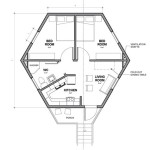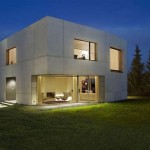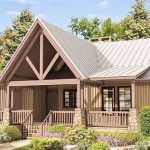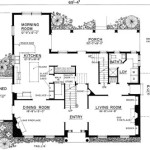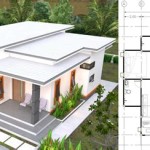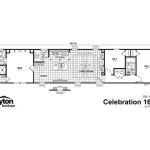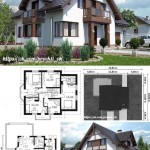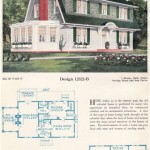Most Efficient Use of Space House Plans
The pursuit of efficient space utilization in house plans has become increasingly significant, driven by factors such as rising land costs, growing urbanization, and a shift towards minimalist lifestyles. Efficient house plans prioritize functionality, ensuring that every square foot contributes meaningfully to the homeowner's daily life. These designs focus on minimizing wasted space, optimizing flow, and incorporating multi-functional elements. A well-designed compact home can feel spacious and comfortable, offering all the necessary amenities without the burden of unnecessary square footage.
The concept of efficient space utilization is not simply about reducing the size of a house. It is about intelligent design choices that maximize usability and create a sense of openness and livability. This often involves careful consideration of layouts, storage solutions, lighting, and material choices. Effective planning can transform a small space into a highly functional and aesthetically pleasing environment. The principles of efficient space utilization are applicable to houses of all sizes, not just small homes. Even in larger homes, optimizing the use of space can lead to a more streamlined and comfortable living experience.
Smart Layout Design for Maximum Functionality
One of the most crucial aspects of efficient space utilization lies in the layout design. Open-concept layouts are commonly employed to create a sense of spaciousness and improve natural light flow. Combining the living room, dining area, and kitchen into a single, unified space eliminates unnecessary walls and maximizes the available area. However, open-concept designs must be carefully planned to avoid creating a feeling of disorganization or lack of definition. Thoughtful zoning, using furniture or subtle changes in flooring, can help delineate different functional areas within the open space.
Another technique involves minimizing hallways and corridors, which often serve as mere passageways with little functional value. Instead, incorporate circulation routes into living areas, making them multi-purpose spaces. For example, a wide entry foyer can double as a mudroom or a small office area. Similarly, a hallway could be lined with bookshelves or cabinets to provide storage and display space. Circular floor plans can also contribute to efficient circulation, minimizing dead-end spaces and creating a more continuous flow throughout the house.
Consideration should be given to the placement of rooms in relation to each other. Grouping rooms with similar functions can streamline daily routines and reduce unnecessary travel within the house. For example, placing the kitchen near the dining area facilitates serving meals, while locating the laundry room near the bedrooms makes chores more convenient. Careful consideration of traffic patterns and activity zones is essential for creating a functional and comfortable living environment.
Vertical space is often an overlooked resource in house design. Designing with varying ceiling heights can visually expand a small room and offer additional storage opportunities. Lofted areas, for example, can be used as bedrooms, offices, or play areas, maximizing the use of available vertical space. Another effective strategy is to incorporate built-in features, such as window seats with storage underneath or recessed niches for displaying artwork. These features not only save space but also add character and personality to the house.
Strategic Storage Solutions for Decluttering and Organizing
Effective storage solutions are paramount for maintaining a clutter-free and organized home, particularly in smaller spaces. Built-in storage, such as shelves, cabinets, and drawers, is a key component of efficient space utilization. This type of storage is integrated directly into the structure of the house, maximizing the available space and minimizing the need for freestanding furniture. Custom-designed storage solutions can be tailored to the specific needs of the homeowner, ensuring that every item has a designated place.
Multi-functional furniture is another valuable tool for maximizing storage potential. Sofa beds, storage ottomans, and coffee tables with hidden compartments offer discreet storage options without sacrificing comfort or style. These pieces can be particularly useful in small living rooms or bedrooms, where space is at a premium. Consider incorporating these features when planning the interior design of the house.
Vertical storage is especially important in areas such as the kitchen and bathrooms. Tall, narrow cabinets can provide ample storage for pantry items or toiletries, while wall-mounted shelves can offer additional surface space for displaying decorative items or storing everyday essentials. Using the full height of walls in these rooms can significantly increase storage capacity without taking up valuable floor space.
Under-utilized spaces, such as the area under the stairs, can be transformed into functional storage areas. This space can be enclosed to create a closet, fitted with drawers or shelves, or even used as a small home office. Clever use of these overlooked areas can significantly increase the overall storage capacity of the house.
Regular decluttering is essential for maintaining an organized home, regardless of the amount of storage available. Periodically removing unwanted or unused items creates more space and simplifies daily life. Encourage homeowners to adopt a minimalist approach and only keep items that are truly needed or valued. This will help to maintain a sense of spaciousness and order, even in a small living environment.
Multi-Functional Spaces and Adaptable Design
Designing spaces that can serve multiple purposes is a cornerstone of efficient space utilization. A guest room, for example, can double as a home office or a hobby room. Incorporating a Murphy bed or a sofa bed allows the room to be easily transformed from a workspace or craft area into a comfortable guest bedroom. This type of flexible design maximizes the utility of each room and reduces the need for dedicated spaces that are only used occasionally.
Dining areas can also be designed with multi-functionality in mind. A large dining table can serve as a workspace for homework, a surface for crafting, or a gathering place for family game nights. Choosing a table with storage drawers underneath can further enhance its functionality. In smaller homes, consider using a drop-leaf table that can be folded down when not in use.
Outdoor spaces can also be designed to be multi-functional. A patio or deck can serve as an extension of the living room, providing an outdoor space for dining, entertaining, or relaxing. Incorporating features such as built-in seating, outdoor kitchens, or fire pits can enhance the functionality and livability of the outdoor space.
Adaptable design principles should also be considered when planning for the future. Designing a house that can easily adapt to changing needs ensures its long-term relevance and usability. For example, incorporating wider doorways and hallways can accommodate mobility aids in the future. Similarly, designing bathrooms with grab bar reinforcement can make them easily accessible for individuals with mobility limitations.
Universal design principles promote accessibility and usability for people of all ages and abilities. Incorporating these principles into the house design can create a more comfortable and inclusive living environment for everyone. Consider elements such as lever-style door handles, rocker-style light switches, and adjustable-height countertops to enhance accessibility and usability throughout the house.
The selection of materials also plays a role in creating a multi-functional and efficient space. For example, using durable and easy-to-clean materials in high-traffic areas can simplify maintenance and extend the lifespan of the house. Choosing materials that are sustainable and environmentally friendly can also contribute to a more healthy and responsible living environment. Thoughtful material selection can enhance both the functionality and the aesthetics of the house.
By carefully considering layout design, storage solutions, and multi-functional spaces, homeowners can create a comfortable and efficient living environment, regardless of the size of their house. These principles can be applied to both new construction and renovation projects, allowing homeowners to maximize the potential of their existing space. The key is to prioritize functionality, optimize flow, and incorporate adaptable design elements that cater to the specific needs and preferences of the occupants.

Affordable Home Design Efficient Floor Plans

Livinghomes And Make It Right Introduce Affordable Green Prefab House Floor Plans Building A Container Home

Top 50 Amazing House Plan Ideas Budget Plans Bungalow Floor Simple

How Do I Build The Best Home In An Area Of 1500 Square Feet 30x50

10 Best 1600 Sq Ft House Plans As Per Vastu Shastra 2024

Choosing The Best Floor Plan For Your Modular Home Next

The Best 2 Bedroom Tiny House Plans Houseplans Blog Com

Best Home Plan In 33 Feet By 40 Good House Plans Simple Budget

Creating Your Dream Home The Best 30x40 House Plan With A Spacious Car Parking Area And Designs Books

6 Best Studio Apartment Layout Ideas And Floor Plan Foyr

